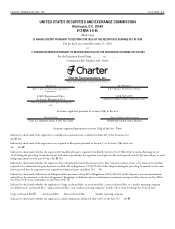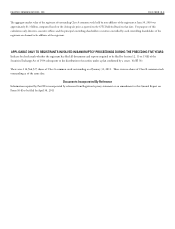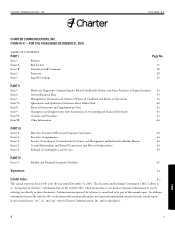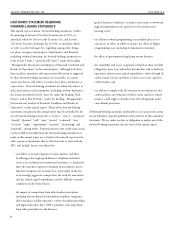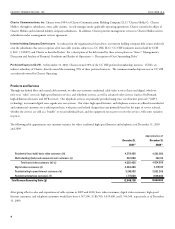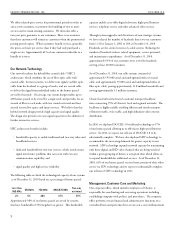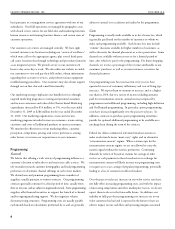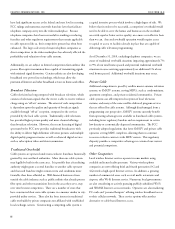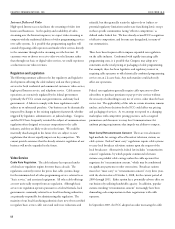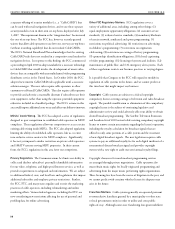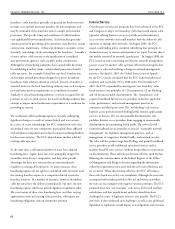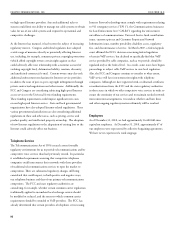Charter 2010 Annual Report Download - page 20
Download and view the complete annual report
Please find page 20 of the 2010 Charter annual report below. You can navigate through the pages in the report by either clicking on the pages listed below, or by using the keyword search tool below to find specific information within the annual report.
We offer reduced-price service for promotional periods in order to
attract new customers, to promote the bundling of two or more
services and to retain existing customers. We often also offer a
two-year price guarantee to our customers. ere is no assurance
that these customers will remain as customers when the promotional
pricing period expires. When customers bundle services, generally
the prices are lower per service than if they had only purchased a
single service. Approximately 61% of our customers subscribe to a
bundle of services.
Our network utilizes the hybrid fiber coaxial cable (“HFC”)
architecture, which combines the use of fiber optic cable with
coaxial cable. In most systems, we deliver our signals via fiber optic
cable from the headend to a group of nodes, and use coaxial cable
to deliver the signal from individual nodes to the homes passed
served by that node. On average, our system design enables up to
400 homes passed to be served by a single node and provides for six
strands of fiber to each node, with two strands activated and four
strands reserved for spares and future services. We believe that this
hybrid network design provides high capacity and signal quality.
e design also provides two-way signal capacity for the addition of
further interactive services.
HFC architecture benefits include:
bandwidth capacity to enable traditional and two-way video and
broadband services;
dedicated bandwidth for two-way services, which avoids return
signal interference problems that can occur with two-way
communication capability; and
signal quality and high service reliability.
e following table sets forth the technological capacity of our systems
as of December 31, 2010 based on a percentage of homes passed:
Approximately 98% of our homes passed are served by systems
that have bandwidth of 550 megahertz or greater. is bandwidth
•
•
•
capacity enables us to offer digital television, high-speed Internet
services, telephone service and other advanced video services.
rough system upgrades and divestitures of non-strategic systems,
we have reduced the number of headends that serve our customers
from 1,138 at January 1, 2001 to 204 at December 31, 2010.
Headends are the control centers of a cable system. Reducing the
number of headends reduces related equipment, service personnel,
and maintenance expenditures. As of December 31, 2010,
approximately 93% of our customers were served by headends
serving at least 10,000 customers.
As of December 31, 2010, our cable systems consisted of
approximately 195,000 aerial and underground miles of coaxial
cable, and approximately 55,000 aerial and underground miles of
fiber optic cable, passing approximately 11.8 million households and
serving approximately 5.1 million customers.
Charter has built and activated a national transport backbone
inter-connecting 95% of Charter’s local and regional networks. e
backbone is highly scalable enabling efficient and timely transport
of Internet traffic, voice traffic, and high definition video content
distribution.
In 2010, we deployed DOCSIS 3.0 wideband technology to 57%
of our homes passed allowing us to offer faster high-speed Internet
service. In 2011, we expect our roll-out of DOCSIS 3.0 to be
substantially complete. We have also deployed SDV technology to
accommodate the increasing demands for greater capacity in our
network. SDV technology expands network capacity by transmitting
only those digital and HD video channels that are being watched
within a given grouping of homes at any given time which allows us
to expand bandwidth for additional services. As of December 31,
2010, 63% of our homes passed received some portion of their video
service via SDV technology and we expect to substantially complete
our roll-out of SDV technology in 2011.
Our corporate office, which includes employees of Charter, is
responsible for coordinating and overseeing operations including
establishing company-wide policies and procedures. e corporate
office performs certain financial and administrative functions on a
centralized basis and performs these services on a cost reimbursement


